

|
Home Updates Hydros Cars Engines Contacts Links Who's who index |
|
|
Who’s who in tethered hydroplanes
Bob Kirtley |
|
Major achievements, positions held Secretary of the North East Coast Association of Model Power Boat Clubs (Heaton and District MPBC,Tynemouth MBC, South Shields Model Yacht club). Power boat section leader SSMYC |
|
How did you start in Hydro’s? Any one person influence you more than any other? |
|
|
I had read and re-read articles and regatta reports, many written by John Benson, in ‘Model Engineer’ and loved the idea of competing in round the pole events. It is difficult to identify one person who influenced me most because I had studied the achievements of John Benson, Arthur Cockman and Bernard Pilliner and had seen Frank Jutton and Jim Bamford running at Victoria when I was a student. I think the one person would have to be Jim Bamford who had written articles describing his experiments. My three burner arrangement is based on one of his, except that I use conical flame tubes, as is my combined water and fuel pump block. He also spoke with infectious enthusiasm about pressures, superheat and power! By 1975 I felt that I had a chance of competing seriously and it was Tom Clement who actually got me involved by showing me what was needed in relation to tethering points, surface props and hulls. He helped with many of my early (sometimes hairy!) experiments and introduced me to the wonderful hydroplane fraternity and I am very grateful to him for that. |
|
What made you choose to run flash steam boats? |
|
| My fascination with flash steam has been there from the early days. I joined SSMYC, aged 14, because I had seen fantastic steam powered models on the lake. The notion of putting a burning blowlamp into a model to generate steam caught my imagination. Many of the models were (and still are) flash steamers including warships, liners and speedboats! | |
|
Several of the members helped me but one in particular, a marine chief engineer called Bob Sutherland took me under his wing. He had a spectacular 5ft long tinplate steam launch called Xerxes. I could not believe the power being delivered by a very small, lightweight, ¾“ x ¾” twin single acting ‘Groves type’ rotary valve engine linked to a single coil flash boiler, running at 200-250psi. I was hooked! Bob Sutherland influenced me tremendously at that stage., showing me how to make water and oil pumps, burners and propellers. I built four tinplate flash steam boats in my teens, including a single step free running hydroplane which took the club straight speed record. Don Walkinshaw owns Xerxes now and it is still running after nearly 80 years. Right: Don and Xerxes |
|
Hulls, how did the design of your hulls evolve? |
|
|
When I began
to build competitive hydros, around the mid 1970s, it seemed clear that
the best speeds in all classes were being produced by 3 point hulls with
surface propellers so that was my starting point. I did not like the
idea of a blowlamp intake right at the front because of anticipated
spray when launching, nor did I want the boiler uptake in front of the
engine because of the risk of getting burnt when starting up! |
|
Do you have an engineering background? |
|
|
I am not a professional engineer but I have done a lot of engineering metalwork. I am a retired Design and Technology teacher and I gained my qualifications at Shoreditch College of Education in the late 1960s. It was a specialist college, which to my delight had a magnificent new three-storey workshop complex resembling a medium sized factory. This included machine shops, foundry, forges, general metalworking rooms, woodworking rooms, drawing offices and stores. Although I did everything, I specialised in metalwork and technical drawing, winning the Harrison (machine tools) prize for engineering metalwork in 1968. Since then I have run Design and Technology departments in several schools. It has been, in the main, a very rewarding career and I have worked with some lovely youngsters over the years. |
|
Which win or achievement has given you the most satisfaction? |
|
|
I can’t identify one on its own but taking the flash steam record for the first time was pretty good. I think it was 72mph from Frank Jutton’s 68mph. The first 100mph run was also an exciting and satisfying milestone. I got a lot of satisfaction from the revival of interest in flash steam after my articles in ‘Model Engineer’ around 1990. Tom Clement took most of the photos and later produced a very good video on the subject. There were soon some new boats on the water and letters from far and wide including Australia and USA. |
|
Current ambition, project or future plans? |
|
|
My ambition in hydroplanes is to take the overall ‘A’ Class record but I have a long way to go to reach 130+mph. I don’t think Pisces II can do it because it is now too heavy due to repairs etc. Perhaps there will be a Pisces III. |
|
| Have you ever run an IC hydro or thought about running one? | |
|
I have not run an IC hydro but I have thought about it. I may still have a go at some stage, though my detailed knowledge of high performance IC engine design is very limited. The main reason for not building one so far is that the flash steamer never fails to present fresh challenges as speeds increase. |
|
What do you consider to be the most crucial element in getting a FS boat to run quickly? |
|
|
There is no single crucial element unless it can be described as
balancing several independently reliable systems.
a)
Stainless steel coil steam generator with
coils wound to allow good combustion and b) Burners with conical flame tubes, which appear to be stable whatever the fuel pressure. c) Poppet valve engine with a dykes ring on the piston, uniflow exhaust and a very short steam cut off.
d)
Geared down water and fuel pumps built into
the same block so that the fuel does not vaporise e) Pressurised lubrication to the poppet valve and cylinder. f) Strong, lightweight hull with the aerodynamics to lift the boat clear of the water. g) Large propeller to use the power available effectively. The key is definitely to balance the heat available with water feed rate and load on the engine. |
|
Is there any boat from the past you would have liked to have seen/run? |
|
|
I would have liked to have seen Bernard Pilliner’s ‘Eega Beeva’. Bernard passed away before I started with hydros but I have read about his self-adjusting sponsons and other ingenious experiments. |
|
Do you have any other modelling or boating interests? |
|
|
I still really enjoy free or straight running boats. There is something traditional and satisfying about running a model across a large lake without radio control. It is a very ‘hands on’ experience. A steam powered liner or warship, for example, would set off at a brisk speed on its direct voyage across the lake, to be caught and returned by a ‘mate’ on the other side, rather than slowly stopping, starting, turning tightly or going astern as many radio controlled craft do. There is nothing wrong with the latter, it’s just not my personal preference (while I can still run anyway!). I have a 6ft 4in long semi-scale liner for which I built the superstructure and steam plant. A fellow club member had made the tinplate hull itself in the 1950s. My best boat is a 5ft 6in long functional flash steam launch, with polished brass funnel, called ‘Aladdin’ (magic lamp) which I built around 1996. It is fast and powerful and has an engine similar to the hydro but with a separate poppet valve for inlet and exhaust. It has twice been national straight running champion. These two craft, together with a start on a turbine for modest performance and modifications to Pisces II occupy my model engineering time at the moment. |
|
|
|
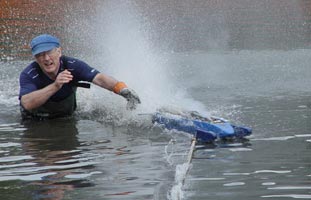 |
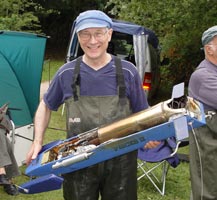 |
| Pisces II engine | Launching Pisces II | Pisces II had just run at 122.53mph |
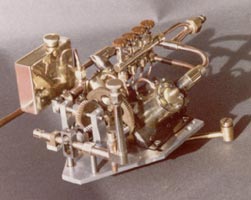 |
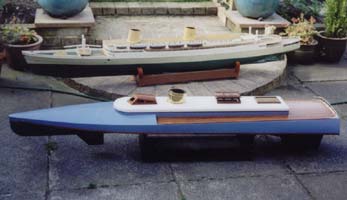 |
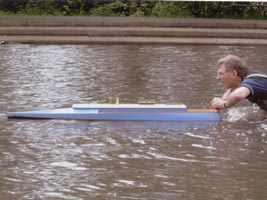 |
| 'Aquarius' engine | Liner 'Aquarius' (rear) and 'Aladdin' | Bob takes aim with 'Aladdin' |
©copyrightRKIRTLEY&OTW2011
Update 2012
|
|
Bob Kirtley presented with MPBA Presidents
Award This year I had the pleasure of presenting the
Presidents Award to Bob Kirtley at the prize giving at his home club
of South Shields. Bob has been an ambassador for the MPBA up on the
North coast for many years, at least 40 that I know of. A competitor
in straight running and tethered hydros regularly travelling around
the country, a fine engineer, modeller and a wealth of knowledge in
steam, probably his favourite subject, something that he will
willingly talk about for hours. Always right at the front when it
comes to helping out at club, area and national regattas, always
willing to help and advise the young members, and old ones like
myself. Quietly spoken a modeller and gentleman, it was a pleasure
to see Bob's face when I stepped out and presented him with his
certificate.
A worthy recipient. |